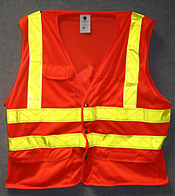
| CONNECTIONS |
IDAHO
ITD
HOME
511 TRAVEL SERVICES
IDAHO
DMV
ITD
NEWS
HIGHWAY
SAFETY
IDAHO STATE POLICE
STATE OF IDAHO
NIATT
NATIONAL
AASHTO
AAMVA
AAA of IDAHO
FEDERAL HIGHWAYS
FEDERAL AVIATION
IDAHO STATE POLICE
NHTSA
NTSB
TRB
U.S. DOT
TRANSPORTER
Archives
Milestones
Comments
Idaho
Transportation
Department
Office of Communications
P.O. Box 7129
Boise, ID 83707
208.334.8005
Fax: 208.334.8563

Working near a highway?
New requirements to be in effect for high-visibility clothes
Civilian clothes for anyone working in the rights-of-way on federal aid highways – whether they are ITD employees, contract workers, emergency personnel or the news media – will no longer be adequate in the rights-of-way on many of Idaho’s highways beginning next month.
 A new rule, requiring the use of high-visibility safety clothing, will go into effect Nov. 24, explains Cheryl Rost, ITD’s Safety and risk Management manager. The Code of Federal Regulations, Part 634, Title 23, requires the use of high-visibility apparel and headwear, Class 2 or 3. The retro-reflective apparel must be worn on all rights-of-way of highways that receive federal aid, including interstates, U.S. highways and state highway, and some local routes.
A new rule, requiring the use of high-visibility safety clothing, will go into effect Nov. 24, explains Cheryl Rost, ITD’s Safety and risk Management manager. The Code of Federal Regulations, Part 634, Title 23, requires the use of high-visibility apparel and headwear, Class 2 or 3. The retro-reflective apparel must be worn on all rights-of-way of highways that receive federal aid, including interstates, U.S. highways and state highway, and some local routes.
Clothing must meet American National Standards Institute/International Safety Equipment Association 107-2004 specifications. The rule will be implemented to lower the likelihood of fatalities or injuries to workers on foot in federal highway work zones.
The rule defines workers as “people on foot whose duties place them within the right-of-way of a Federal-Aid highway, such as highway construction and maintenance forces, survey crews, utility crews, responders to incidents within the right-of-way, and law enforcement personnel when directing traffic, investigating crashes and handling lane closures, obstructed roadways and disasters within the right-of-way of a Federal-aid highway.”
Work zone deaths
More than 10 workers are killed annually and more than 20,000 others are injured in the highway and street construction industry, according to the Federal Highway Administration. The new rule requiring high-visibility clothes and headwear is designed to help reduce those numbers.
Citing Bureau of Labor Statistics, FHWA said approximately 350,000 workers are involved in highway construction activities across the nation at any given time. FHWA determined the rule requiring high-visibility clothing would not adversely affect any sector of the economy.
“In addition, these changes will not interfere with any action taken or planned by another agency and would not materially alter the budgetary impact of any entitlements, grants, user fees, or loan programs.”
There was a two-year phase-in period for the rule that began in the fall of 2006 and ends next month. The transition period allowed sufficient time for entities to replace existing garments to comply with the new standard.
ITD requires employees to wear a Class 2 minimum outer garment when working on the highway and requires contractor compliance with the Manual on Uniform Traffic Control Devices (MUTCD).
Published 10-10-8